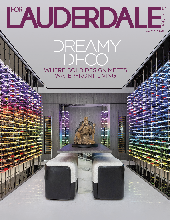
These days, not everything in Angelo Elia’s life is simple. The chef and restaurateur has been in South Florida for 22 years and in that time, things have changed. For starters, one restaurant has grown into a handful of locations. There’s the upmarket Casa D’Angelo, today a truly tri-county endeavor with Boca Raton and Aventura locations in addition to the Fort Lauderdale flagship. There are the more casual Angelo Elia Pizza, Bar, Tapas – the Fort Lauderdale location is one of three in Broward, and another’s in Delray Beach. And in Oakland Park, there’s Angelo Elia the Bakery Bar – a casual sandwich place that, as the name indicates, also takes care of all your dessert or bread needs.
It’s a business that keeps Elia busy and on the move – on the day Fort Lauderdale Magazine catches up with him, he’s just pulled up at the Aventura location. But one advantage of working for more than two decades in an area is that you’ve got longtime employees you trust who will run places to your standard when you can’t be there all the time.
Beyond that, the business may have become bigger and more complicated. But for Elia, a native of the southern Italian port city of Salerno, the ethos that got him here remains the same.

“I’m the kind of person who doesn’t follow what everybody else does,” he says. “I have my own creativity. I believe in simplicity. I believe in food that tastes great. That’s what I believe; that’s my culture. That’s Italian culture. I’m not going to mix my fish with papaya, mango.”
“That’s the way I cook, that’s me, that’s my mentality.”
It’s a philosophy that was tested when he first arrived in South Florida. This wasn’t his first U.S. stop; he’d previously worked in New York. Coming to Fort Lauderdale required adjustments. Restaurant patrons here were not accustomed to what he wanted to do.
“It was a little difficult,” he says. “But over the years I’ve seen an incredible difference in the guests that come to the restaurant. They are more sophisticated; they enjoy different wines now.” He remembers when he first served burrata; nobody who came in had ever heard of it. “And now,” he says, ”burrata is in every corner of South Florida.”
Elia’s not quick to give himself too much credit, but he will say he may have played some small role in changing that, in being one of a handful of chefs and restaurateurs who saw a changing Fort Lauderdale as something other than a big town with a rowdy tourism industry. Again though, he doesn’t want to make it sound like he’s out there doing anything fancy or complicated.

“I am a traditional chef. I’m traditional, and also I’ve evolved myself over the years,” he says. “I travel to Italy, I go to my own town, I go to Florence, I go to the south part of Naples, and everywhere I go I try to get better.”
It’s common to hear chefs and restaurateurs talk about quality and freshness and only using the best. For Elia, that’s something that has to be built into the business model. Being an established presence who owns and controls every aspect of his business means he can set quality standards exactly where he wants them.
“I can keep my philosophy,” he says. “A lot of chefs, they cannot keep their philosophy. I have no partner. [If] I have a bad week, I have a bad week. I have the freedom.
“For me, quality is number one. If [I was] not dealing with quality today, I would have a lot more money in my bank. I have pride, and I have an ego to bring only the best. I don’t cut quality, I charge the money, and that’s Casa D’Angelo.
“I am my own self,” he says. “I believe in what I’m doing.”
The Dish: Risotti Al Funghi Porcini
Ingredients
- 1/4 cup extra-virgin olive oil
- 1 medium onion, cut into 1/4-inch dice
- 2 cups Arborio rice
- 1 ounce fresh porcini broken into pieces with your hands
- 1/2 cup white wine
- 3 1/2 cups chicken stock, hot
- 1/2 pound fresh porcini cleaned and thinly sliced
- 4 tablespoons (1/2 stick) unsalted butter
- 1/2 cup freshly grated Parmigiano-Reggiano
Method
In a 12- to 14-inch skillet, heat the olive oil over medium heat. Add the onion and cook until softened and translucent but not browned, 8 to 10 minutes. Once the onions are translucent, add the rice and stir with a wooden spoon until toasted and opaque, or about 3 to 4 minutes. Add the dried porcini.
Add the wine to the toasting rice, and then add a 4- to 6-ounce ladle of stock and cook, stirring, until it is absorbed. Continue adding the stock a ladle at a time, waiting until the liquid is absorbed before adding more. Just before adding the last 4 to 6 ounces of stock, add the freshly sliced porcini. Cook until the rice is tender and creamy and yet still a little al dente, about 15 minutes. Stir in the butter and cheese until well mixed. Portion risotto into 4 warmed serving plates, serving with extra cheese.












